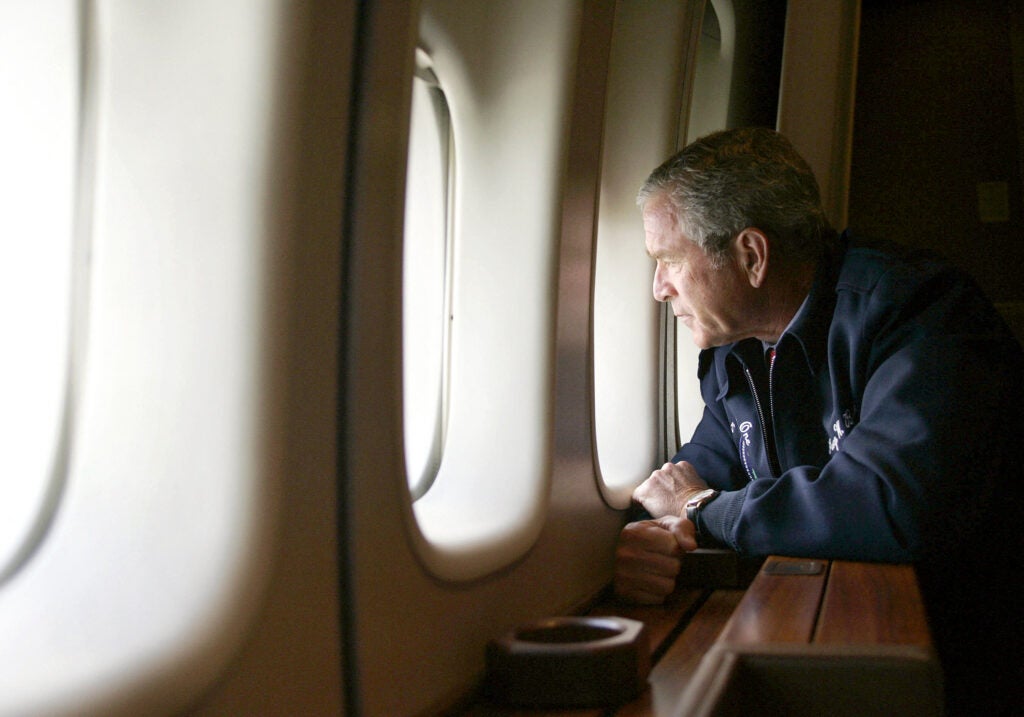The Flood That Might Sink Kamala Harris
Bradley Devlin /
Hurricane Katrina, historian Douglas Brinkley wrote for Vanity Fair on the 10th anniversary of the 2005 storm, was the “Flood That Sank George W. Bush.” Ten years from now, the American people might look back at the current natural disaster and say that Hurricane Helene was the flood that sank Vice President Kamala Harris.
Although 19 years apart, the failures that plagued the Bush-Cheney administration’s response to Hurricane Katrina and the Biden-Harris administration’s response to Hurricane Helene are strikingly similar.
When Katrina made landfall on Aug. 29, 2005, Bush was on his 1,600-acre ranch in Crawford, Texas. The president had been away from the White House for more than three weeks, working with a reduced staff and reduced resources from his Crawford property. Bush received his daily intelligence briefings from a secure trailer parked across the street.
The Bush administration did, however, get to work before Katrina struck by pre-positioning assets throughout the Southeast.
The Federal Emergency Management Agency, or FEMA, pre-positioned more than 3.5 million liters of water, nearly 2 million meals, and 33 medical teams in what became the largest preparation of federal disaster assistance in the nation’s history.
Although Bush was slow to act, he was aggressive when he did, signing emergency declarations for Louisiana, Mississippi, and Alabama in quick succession at the requests of the respective governors.
Nevertheless, the president remained in Crawford, Texas. It wasn’t until the morning of Aug. 30, 2005, when Bush determined he would return to Washington. First, however, Bush made an appearance in San Diego for a scheduled address at a V-J Day celebration.
Bush began his remarks by expressing concern for and solidarity with those affected by Hurricane Katrina, but it was what happened on the flight back to D.C. that defined Bush’s response to that storm.
At the request of top political adviser Karl Rove, Bush agreed to fly over and survey the wreckage left in Katrina’s wake. Bush and his staff refrained from visiting the disaster area to avoid pulling resources away from the rescue effort. From thousands of feet above, Bush stared down in dismay at the devastation while photographers snapped pictures.
“The photo-op of the man in charge staring out the window of his plane was disastrous.” journalist Douglas Brinkley wrote, “the sight of a man slumming, a man in a bubble, a man deluged.”

Bush wrote about the photos in his 2010 book “Decision Points”:
When the pictures were released, I realized I had made a serious mistake. The photo of me hovering over the damage suggested I was detached from the suffering on the ground. That wasn’t how I felt. But once the public impression was formed, I couldn’t change it.
Three days after Hurricane Katrina made landfall, on Sept. 2, 2005, Bush made his first trip to the affected area.
For Biden and Harris, it took six days after Hurricane Helene made landfall for the president and vice president to survey the wreckage from the ground.
Like the Bush administration, the Biden-Harris administration had FEMA pre-positioning assets in areas expected to be hit by the storm: 14 urban search and rescue teams, 1.6 million liters of water, and 2.7 million meals. Biden signed emergency declarations requested by Alabama, Florida, Georgia, North Carolina, and South Carolina.
And, like Bush, Biden and Harris didn’t oversee the federal government’s initial response from the White House.
The president was at Rehoboth Beach, Delaware, over the weekend, but cut his time short and returned Sunday to Washington. When reporters asked Biden why he wasn’t commanding the federal response from the White House, Biden said he “was commanding it.”
“I was on the phone for at least two hours yesterday and the day before as well,” the president said. “l command it. It’s called a telephone.”
Harris, however, didn’t return to Washington until Monday. The vice president was busy fundraising and campaigning on the West Coast when Helene struck. At fundraisers in San Francisco and Los Angeles, Harris hobnobbed with megadonors, some of whom spent nearly $1 million for a ticket to meet the vice president. She raised $55 million for her campaign while the Southeast suffered.
Harris, however, did release a statement saying: “My heart goes out to everyone impacted by the devastation unleashed by Hurricane Helene. As we continue to respond and as communities recover, our administration will remain in constant contact with state and local officials.”
Harris posted a photo on the social media platform X that allegedly shows her on the phone with FEMA Administrator Deanne Criswell while flying from California to Nevada for more campaign events. She spoke Sunday night at a rally in Las Vegas, but cut short her time there to rush back to Washington for a briefing at FEMA headquarters.
I was just briefed by @FEMA_Deanne Criswell on the latest developments about the ongoing impacts of Hurricane Helene. We also discussed our Administration's continued actions to support emergency response and recovery.
— Vice President Kamala Harris (@VP) September 30, 2024
I also spoke with @NC_Governor Cooper about the ongoing… pic.twitter.com/nlZPB0h3mO
Bush’s absence from the scene in a time of crisis and the images of him flying over Hurricane Katrina’s devastation left an indelible stain on the 43rd president’s tenure.
A Washington Post-ABC News poll in September 2005 found that Bush’s approval ratings were the lowest he had received up until that point. Trust in Bush during a crisis cratered. It was all downhill from there.
In Bush’s own words, “the legacy of fall 2005 lingered for the rest of my time in office.”
The legacy of fall 2024 might linger for Harris as well. Lucky for her, that might not be too long.
